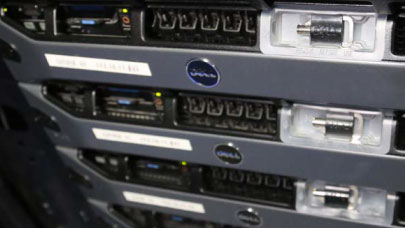Thierry Auzelle is director of the storage division, Enterprise Group, HP France.
In terms of data storage, flash storage solutions are progressing irresistibly. The arguments are technical as well as economic.
Many notebook users or ultrabooks are now experiencing the real benefits of flash memory storage, or SSD, replacing hard drives for weight relief, rapid startup boot, and overall performance improvement. The specialized retailer FNAC estimates that in 2 years time, 50% of laptops will be full flash. In business, the use of flash memory to replace disks is already well known for its ability to accelerate dramatically, and immediately, slow applications. Yet according to a recent IDC study with 178 companies and 23 IT service companies (*), only 5.8% of companies surveyed have adopted full flash storage enclosures. They did it for specific needs, independent of the question of the volume. And 30% use mixed or hybrid storage arrays, ie partially flash. According to IDC, hybrid configurations will operate for many years to come.
The main trends
The capacity of flash storage systems will continue to rise: the first flash modules of 4 terabytes (TB) in only 2.5 inches are appearing. Which is six times better than the most recent record. And the price / capacity ratio will continue to improve. Prices will fall further: in 2018, the price of one terabyte of flash memory will be the same than conventional hard disks. The “100% Flash” approach is already proving more economical. Studies show that, as of now, the overall cost of SSDs, including operation and maintenance, is less than that of conventional discs. One explanation is the impact of the techniques of thin provisioning (forecast management capacity) and deduplication, which optimize capacity and help reduce costs.
The price objection
Many companies suggest the net price of SSDs, would remain high. In fact, one needs to calculate the total cost, up to the scale of the company’s data center. It should also enhance the resulting benefits for users. IDC noted: “We must stop thinking that the flash is expensive. We must change our approach and detect target applications. ” Is it that we can do without flash? Yes, but the anti-SSD arguments have less and less weight. The flash solutions will gradually impose themselves naturally, because of the advantages in terms of density, performance, and operational simplicity. According to IDC, sales of all flash and hybrid systems in the 1st quarter 2015 were up + 81.6% compared to 2014, reaching 403.1 million dollars.
The concrete benefits
The boot procedure are significantly accelerated. The standard levels of storage (‘gold’, ‘silver’, ‘bronze’), always tedious to manage, disappear. Immediately we gain flexibility because the flash configurations are used to create classes of easily manageable services. In addition, the provisioning useful capacity is significantly simpler to orchestrate by administrators.
What is flash useful for?
It is sometimes objected that some applications are not necessarily benefitting from flash storage. That’s true, but only partially so. Some Big data applications, object storage filesystems or very large scale video streams will not always be adapted to the solutions’ flash ‘. But overall, investment in flash solutions can be quickly profitable. It should in particular benefit the critical datacenter parts that uses conventional hard drives that consume more energy, emit more heat, take up more space, and are disturbed by vibration or pollution. Flash does not suffer from these disadvantages.
IDC states: “New technologies optimize the space in the storage array (thin provisioning, deduplication) – which diminishes the TCO (Total cost of ownership).”
IDC continues: ” Flash storage is 8 times faster than conventional hard drives and is between 25 and 35 times faster in batch workloads (…) Flash brings a breath of fresh air to the servers, releasing the CPU loads induced by a slow response time in storage. It gives a second life to old servers and extends the life of the servers. It increases the level of consolidation with more databases by server instances, more VMs per physical server, etc. This also results in a 50% decrease in license costs. ”
SSDs new endurance
Another objection comes up frequently, involving SSD modules’ endurance, which would be limited. It should be noted first that endurance is measured by the number of rewrites per day or DWPD (Data write per day). A recent White Paper (*) compares the different technologies in terms of endurance (write rates on cells or cycles P / E): Enterprise NAND SLC (Single-Level cells) versus MLC Enterprise NAND (Multi-level cells). It shows that two waves of technology have followed:
Wave 1: this was the emergence of technologies SLC (Single-level cells), in small capacities (200-400 GB). On storage arrays, this test was important because DWPD arrays, such as servers, would manage overall endurance by driving an even distribution of wear cells. This avoided deviate too early still usable cells and thus preserve capacity.
Wave 2 is the advent of second generation MLC NAND 2 on Multiple-level cell technologies. Here, each component SSD itself manages, independently, the cell wear distribution. As in the case, for example, of the Sandisk FlashGuard technology wich improves the endurance of MLC modules 10 times. This is also true with the 3PAR (HP) high capacity (1.92 TB and 3.84 TB) flash modules. With this enhancement, the cost of storage per TB is now equal to that of standard hard drives.
In conclusion, the take-off of flash solutions is confirmed irresistibly. Business managers and executives quickly understand the practical benefits. The manufacturing costs of NAND 2D / 3D will continue to decline. Traditional HDD drives will quickly be surpassed in terms of ratio performance / capacity. All companies that have adopted the ‘full flash’ say they are satisfied or very satisfied, and they took this option with a view to 10 years.
(*) White Paper: SSD Endurance. Source: HP (05/2015)
http://h20195.www2.hp.com/v2/getpdf.aspx/4AA5-7601ENW.pdf?ver=1.0
More around this topic...
© HPC Today 2024 - All rights reserved.
Thank you for reading HPC Today.




























